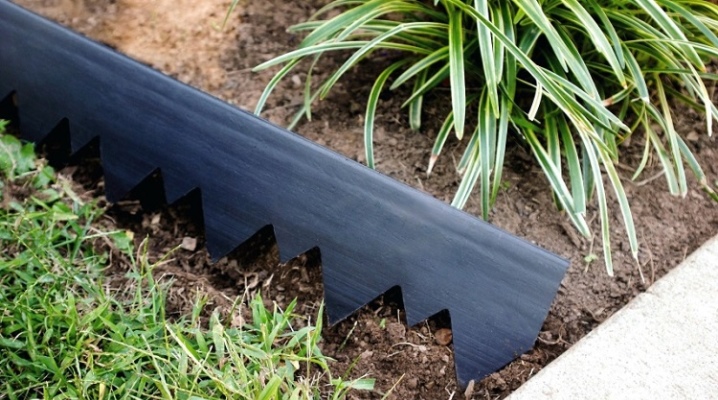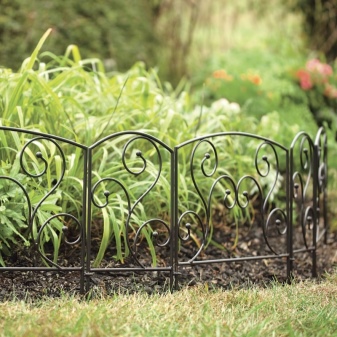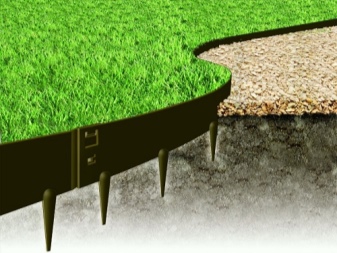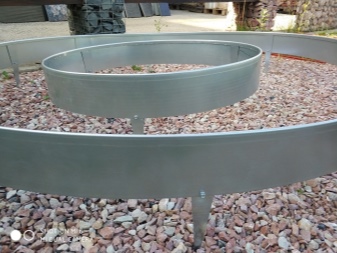Metal border

Metal curbs are an important component in the design of garden and park areas. They can be made in the form of curb strips for paths and lawns, as garden curbs for paving slabs and flower beds. In addition to the installation features, it is advisable to study in advance the main examples in landscape design.


Peculiarities
Landscaping and the very arrangement of a garden, vegetable garden, lawn or mixed house area implies a clear delineation of the main zones. This separation is possible with a wide variety of materials. However, one of the best options for such a design is deservedly a metal border. This solution is different:
- reliability;
- mechanical strength;
- durability;
- low visibility;
- comparative ease of installation (no time-consuming work with concrete or mortar).
The metal curb can be used for both paths and lawns. In any case, it is resistant to temperature fluctuations and precipitation. Rodents and insects do not eat metal, do not infect microscopic and visible fungi. The shape of the structure is preserved, and from the metal it is possible to create lines that are quite varied in appearance.
Of course, there are also disadvantages - comparative severity, corrosion hazard, cost. But at the same time, the germination of weeds is guaranteed to be blocked.


Varieties
The main thing in garden borders is the material from which they are made. Carbon steel is pretty tough. It is the increase in the carbon content with a relatively small amount of other improving components that is its main chemical characteristic. In contrast, stainless steel contains not only carbon, but also chromium. Therefore, a much greater resistance of the fence to adverse conditions and intense moisture is guaranteed.
However, stainless steel is difficult to machine. It is for this reason that the use of ferrous metal is still much more attractive if it is planned to equip a curly barrier. The shape of the border itself is also important. Strips for metal beds are widely used - officially they are called border tape. Usually the metal is 1 mm thick.


Manufacturers supplement their products with teeth, which facilitates subsequent assembly. The deepening of the teeth is usually 100 mm, while repeating the geometry of the edge of the path or flower bed zone. Important: the part of the structure visible from the outside cannot be more than 2 cm. The bar barrier is made, as the name itself indicates, from metal bars of various sections. Usually, such products have a purely decorative role, therefore, they often try to make them in the same style as the external fence in the country, thereby ensuring the harmony of the composition.
A separate type of metal barriers are curbs designed for finishing paving slabs. They successfully replace conventional concrete or other bulky blocks. You can use such structures at the junction not only with ordinary lawns, but also with asphalt paths. And also guaranteed compatibility with dropout tracks. Some manufacturers provide joining to concrete substrates.


Mounting
Ground installation of a tape border is practiced in cases where flower beds are organized in several tiers, but it is also useful for high beds. Usually, the required piece of tape is cut off, which is displayed along the pre-marked line. You can connect the ends with a stapler. The configuration of the future ridge is marked with pegs. The distance between them is at least 0.5 m. When everything is prepared, the frame is filled with earth and the ridges themselves are made out.
The in-depth installation diagram looks different. They start by outlining the size of future flower beds, garden paths, and tree-trunk circles. When the contour is drawn, a narrow groove should be dug. A curb is mounted into this moat, which is dug in from both sides. A maximum of 20 mm of construction is brought to the surface. The depth of closure is determined by the plants planted on the site. If perennials grow there, it will be at least 15-20 cm. Otherwise, even the metal may suffer from the roots (or interfere with the normal development of plants). In other cases, it is enough with a margin of 10-15 cm.


The borders for the beds or flower beds should be about 5-7 cm above the surface, which will prevent unnecessary water consumption for irrigation due to its spreading along the sides of the flower bed. For paths and areas, the requirement is the opposite - the barrier must be exactly at the level of the main surface, so that there are fewer puddles after rain or in spring.
A sand and gravel cushion is formed under any curbs. To increase resistance to adverse conditions, a waterproofing layer is provided. Usually, a polyethylene film or roofing material acts as a waterproofing. All components are carefully adjusted and fixed well.
A "boot" helps to prevent horizontal shift, in which there is no need for such an addition on dense soils.


Examples in landscape design
Curb tape can be very attractive. Here are some examples.
- Here it bends pretty much, but visually it seems to be lost against the background of a bright flower bed. However, this can hardly be considered a disadvantage.

- A metal fence can have a much lighter appearance. The brilliant solution is well received.

- The enclosing structure is sometimes made in the form of a figured fence.

In the next video you can take a look at the Kekkila garden metal curb.































































The comment was sent successfully.